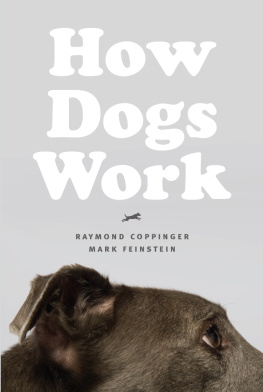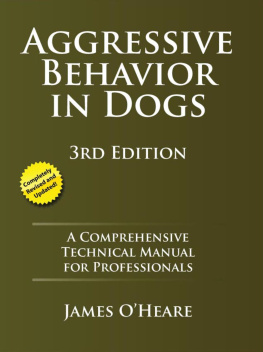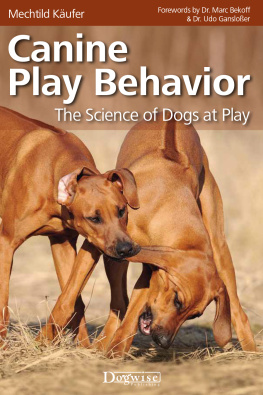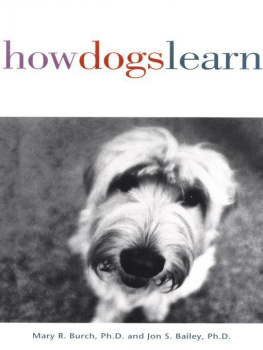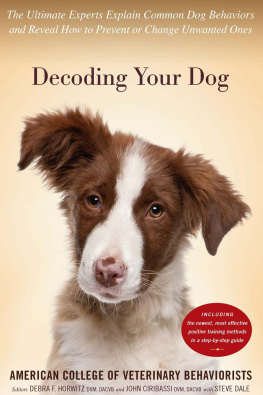Coppinger Raymond - How Dogs Work
Here you can read online Coppinger Raymond - How Dogs Work full text of the book (entire story) in english for free. Download pdf and epub, get meaning, cover and reviews about this ebook. City: Chicago;London, year: 2015, publisher: The University of Chicago Press, genre: Romance novel. Description of the work, (preface) as well as reviews are available. Best literature library LitArk.com created for fans of good reading and offers a wide selection of genres:
Romance novel
Science fiction
Adventure
Detective
Science
History
Home and family
Prose
Art
Politics
Computer
Non-fiction
Religion
Business
Children
Humor
Choose a favorite category and find really read worthwhile books. Enjoy immersion in the world of imagination, feel the emotions of the characters or learn something new for yourself, make an fascinating discovery.
- Book:How Dogs Work
- Author:
- Publisher:The University of Chicago Press
- Genre:
- Year:2015
- City:Chicago;London
- Rating:4 / 5
- Favourites:Add to favourites
- Your mark:
- 80
- 1
- 2
- 3
- 4
- 5
How Dogs Work: summary, description and annotation
We offer to read an annotation, description, summary or preface (depends on what the author of the book "How Dogs Work" wrote himself). If you haven't found the necessary information about the book — write in the comments, we will try to find it.
How Dogs Work — read online for free the complete book (whole text) full work
Below is the text of the book, divided by pages. System saving the place of the last page read, allows you to conveniently read the book "How Dogs Work" online for free, without having to search again every time where you left off. Put a bookmark, and you can go to the page where you finished reading at any time.
Font size:
Interval:
Bookmark:
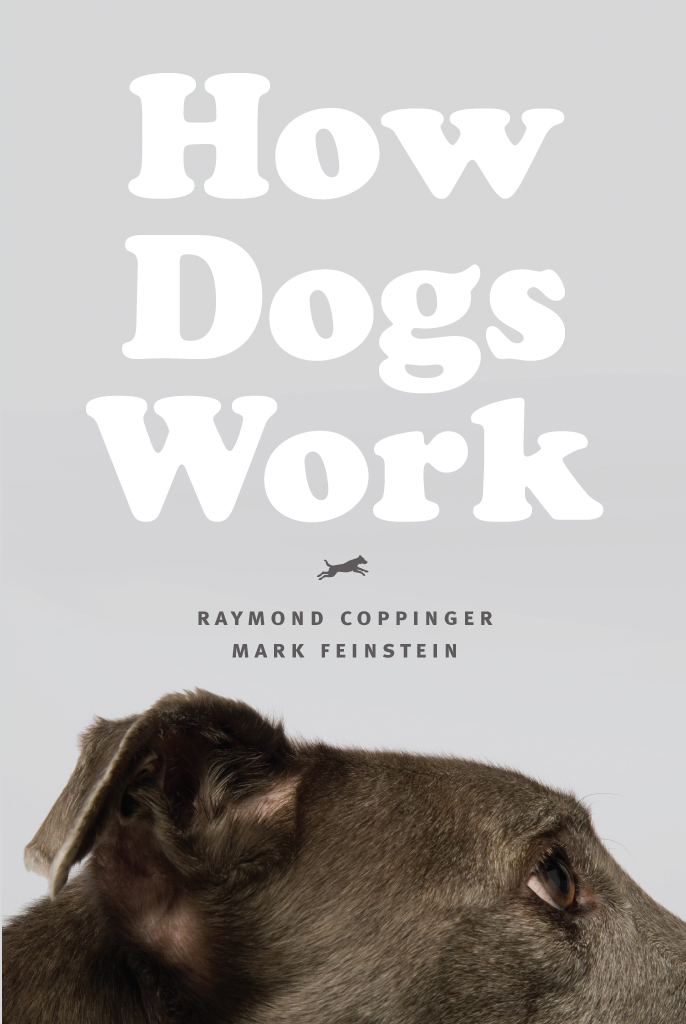
Raymond Coppinger Mark Feinstein
Foreword by Gordon M. Burghardt
The University of Chicago Press : Chicago and London
RAYMOND COPPINGER is professor emeritus of biology at Hampshire College. His books include Dogs: A New Understanding of Canine Origin, Behavior, and Evolution, also published by the University of Chicago Press. MARK FEINSTEIN is professor of cognitive science at Hampshire College.
The University of Chicago Press, Chicago 60637
The University of Chicago Press, Ltd., London
2015 by The University of Chicago
Foreword 2015 by Gordon M. Burghardt
All rights reserved. Published 2015.
Printed in the United States of America
24 23 22 21 20 19 18 17 16 15 1 2 3 4 5
ISBN-13: 9780-226128139 (cloth)
ISBN-13: 9780-226322704 (e-book)
DOI: 10.7208/chicago/9780226322704.001.0001
Library of Congress Cataloging-in-Publication Data
Coppinger, Raymond, author.
How dogs work / Raymond Coppinger and Mark Feinstein.
pages cm
Includes bibliographical references and index.
ISBN 978-0-226-12813-9 (cloth : alkaline paper) ISBN 978-0-226-32270-4 (ebook) 1. DogsBehavior. 2. CanisBehavior. I. Feinstein, Mark H., author. II. Title.
QL737.C22C64 2015
636.7dc23
2015015809
This paper meets the requirements of ANSI / NISO Z39.481992 (Permanence of Paper).
In memory of Erich Klinghammer, the founder of Wolf Park
It is a great pleasure for me to compose the foreword to this book by Ray Coppinger and Mark Feinstein devoted to the ethology of dogs. It is doubly a pleasure as the book is dedicated to both Wolf Park in Indiana and the late Dr. Erich Klinghammer, who founded it. Erich Klinghammer was one of my teachers, a member of my dissertation committee at the University of Chicago and, subsequently, a long-time friend. Although he began his career by carrying out some of the first studies on sexual imprinting in altricial bird species, he always loved dogs, especially German shepherds. It was his dog Gitta who, over fifty years ago, found a pregnant garter snake on his research farm in northern Indiana. Knowing my interest in snakes, Erich gave her to me; the babies born to this snake led to my first snake research, resulted in my dissertation topic, and were a key factor in my subsequent career in serpentine ethology. Both Erich and Gitta were acknowledged in the first publication (Burghardt 1966); that Gitta was a dog seemed irrelevant to mention. So dogs and Erich greatly influenced my career. When Erich developed serious allergies to birds, he changed his scholarly interest to the behavior of dogs and other canids, advocated for proper captive conditions for wolves, championed wolf conservation, and promoted ethology by translating important books from German.
Ray Coppinger, first author of this book, I have known for almost as long, and with great fondness, since his sense of humor broke the tension of perhaps the most embarrassing event in my life as a scientist. This occurred at an American Association for the Advancement of Science/Animal Behavior Society meeting in Dallas in 1968 when he followed me in the same session, presenting his dissertation work on birds. So Ray is also a refugee from the avian world, who with students and colleagues has studied the detailed workings of dog behavior. His important, but underappreciated, theoretical writings (Coppinger and Smith 1989) greatly informed my own thinking on the evolution of animal behavior, especially play.
This book on the ethology of dog behavior rides the crest of a renewed scientific interest in dogs and their evolution, behavior, cognition, and domestication. The great apes, humans closest relatives, have been iconic mirrors for human behavior going back to the nineteenth century, including the famous World War Iera insight experiments of Wolfgang Kohler, captive studies of Robert Yerkes in the 1920s, the pioneering field research of Jane Goodall in the 1960s, the language trained apes of the 1970s, and the cognitively and socially adept apes so widespread today in both popular books and the burgeoning field termed comparative cognition. But dogs are pushing their way into the august pantheon of super smart animalsto the extent that ape researchers are switching some of their efforts to our canine cousins.
Actually, however, the history of dogs as useful entries into the mysteries and origins of human behavior is quite ancient. Charles Darwin, who loved dogs more than any other animal, discussed breed differences in behavior and their scientific importance in his famous chapter on instinct in the Origin of Species in 1859. In his later Descent of Man and Selection in Relation to Sex (Darwin 1871) and in his book on emotions (Darwin 1872), he used dogs as exemplars of his three principles of emotions as well as arguing that dogs have attributes we think most distinctive of humanity such as loyalty, love, jealousy, pride, shame, imagination, reason, abstraction, and rudiments of language. In the seminal book on mental evolution by Darwins protg, George John Romanes, dogs, but not other carnivores, were ranked with apes as most humanlike in their mental attainments (Romanes 1883).
Konrad Lorenz, a key founder of ethology, also had a lifelong love for dogs, resulting in the first popular ethological book on dog behavior and evolution, Man Meets Dog (Lorenz 1954). Here a more scientifically measured and biologically objective treatment of dog behavior was presented. Interestingly, it took the cognitive revolution in comparative psychology and ethology to bring dogs back to the forefront of research, accompanied by modern molecular genetics working out the relationships among the various breeds, to make it timely to look closely once again at dogs through an ethological lens. How Dogs Work is a true milestone and worthy successor to Lorenz. It gathers together much of the massive amount of new biological and ethological findings on dogs, wolves, and their relatives and is authoritatively written by canine behavior researchers with a long history of seminal contributions. Furthermore, the authors focus on particular breeds rather than the generic dog, maintain an ethological approach throughout, and, like Lorenz, present provocative, not consensus, views on many important aspects of dog behavior. Thus, not only will dog owners and aficionados learn much from this wide-ranging book about both dogs and science but dog professionals and canine scientists will have some persistent beliefs challenged as well.
This last claim derives from the fact that current approaches to comparative animal cognition using ingenuous methods not only highlight the cognitive complexity and problem-solving abilities of apes, monkeys, dogs, and other species but also facilitate the entry of uncritical anthropomorphic thinking into the interpretation of behavior. Such anthropomorphism, often considered sins that only pet owners and nonscientists commit, can actually enter the work and vocabulary of professional scientists themselves. This happens due to competition among researchers to show that apes, dogs, and other animals have humanlike abilities based on a tendency to view other animals through our psychology, not theirs. Such competition has led to continued debates between the promoters of animals having human smarts and killjoys who try to keep researchers grounded on the most parsimonious, even if strained and unlikely, interpretations.
Enter this stimulating book, which negotiates between cognitive and behaviorist extremes and discusses and interprets the behavior of dogs with the rich conceptual tools of ethology and basic animal learning processes. Although focusing on the fascinating behavior of sled, guard, and herding dogs, as well as wolves, the modes of thinking about behavior illustrated here can and should be extended to many more canine breeds and relatives. This bookunabashedly adapting and applying central tenets and methods of comparative ethology to understanding dogsactually sets forth new ways of looking at the behavior of any and all species, including our own. It takes seriously Lorenzs insight that behavior is as much a characteristic trait of animals species as are their anatomy and physiology. The wonderful photographs accompanying the text enable readers to interpret the postures, expressions, and behavioral dynamics of dogs and wolves, greatly enhancing understanding and enjoyment of these animals, much as being able to identify trees in a forest enriches the experience of hiking in the woods.
Font size:
Interval:
Bookmark:
Similar books «How Dogs Work»
Look at similar books to How Dogs Work. We have selected literature similar in name and meaning in the hope of providing readers with more options to find new, interesting, not yet read works.
Discussion, reviews of the book How Dogs Work and just readers' own opinions. Leave your comments, write what you think about the work, its meaning or the main characters. Specify what exactly you liked and what you didn't like, and why you think so.

